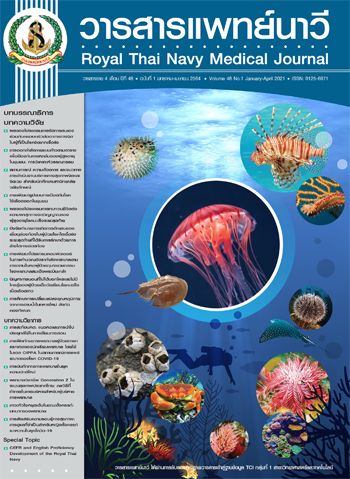Factors Predicting Peritonitis in Patients with End-stage Renal Disease undergoing Peritoneal Dialysis
Main Article Content
Abstract
The purpose of this retrospective cohort study was to examine the incidence and factors associated with peritonitis among the patients undergoing peritoneal dialysis. The data were collected from medical records of the patient and peritoneal dialysis excel data-based of 250 patients at the hemodialysis unit, Buddhasothorn Hospital during 2014 - 2019. The purposive sampling was used to recruit the participants. The data were collected using patient and laboratory record form. The data were analyzed using descriptive statistics, independent t-test, relative risk, and Binary logistic regression.
The results revealed that 1) The incidence of first peritonitis episodes of end-stage kidney disease patients undergoing continuous ambulatory peritoneal dialysis was 20 percent. 2) The patients undergoing continuous ambulatory peritoneal dialysis who have a history of steroid use more likely to get peritonitis 1.90 times than those who have no history of steroid use (OR = 1.9, 95%CI = 1.0 - 3.6, p = .045). The increasing of 1 gm% of serum albumin level in patient undergoing peritoneal dialysis will decreases the risk of the first episode of peritonitis 0.5 time (OR = .5, 95%CI = .3 - .9, p = .022). The patient who has a smoking history more likely to get peritonitis 1.78 times than those who have no history of smoking (OR = 1.8, 95%CI = 1.2 - 2.7, p = .008). The three predictors explained 14.2% of the variance (Nagelkerke R2 = .142) in predicting the first episode of peritonitis among patients with end-stage renal disease undergoing peritoneal dialysis.
Based on the results of this study steroid use, albumin level, and smoking history could predict peritonitis. The health care providers should establish strategies to prevent peritonitis, especially malnutrition prevention, harmful steroids used, and programs promoting smoking cessation.
Article Details

This work is licensed under a Creative Commons Attribution-NonCommercial-NoDerivatives 4.0 International License.
References
2. National Health Security Office. National Health Security Office fund management manual, fiscal year 2019. Nonthaburi: Sahamit Printing Leasing & Leasing; 2018. (in Thai).
3. Andreoli MCC, Totoli C. Peritoneal dialysis. Rev Assoc Med Bras 2020;66(Suppl 1):S37-44.
4. Tiawilai T, Tantivichitvej R. The incidence and risk factors of first peritonitis episode in continuous ambulatory peritoneal dialysis patients of Photharam Hospital. Region 4-5 Medical Journal 2020;39(1):51-64. (in Thai).
5. Kaitwatcharachai S, Kaitwatcharachai C. Risk factor for developing first episode of peritonitis in patients undergoing CAPD. Journal of Medicine and Health Sciences 2012;19(3):29-35. (in Thai).
6. Somboon K, Kamsa-ard S. Epidemiology and treatment outcome of peritoneal dialysis (PD)-related peritonitis. Mahasarakham Hospital Journal 2019;16(1):13-21. (in Thai).
7. Tungkasereerak P. Peritoneal dialysis-related infection at Surin hospital. Srinagarind Med J 2559;31(4):167-72. (in Thai).
8. Wai-Ki Kwong V, Kam-Tao Li P. Peritoneal dialysis in Asia. Kidney Dis 2015;1:147-56.
9. Salzer WL. Peritoneal dialysis-related peritonitis: challenges and solutions. Int J Nephrol Renovasc Dis 2018;11:173-86.
10. Abdul Salim S, Fülöp T. Peritonitis in peritoneal dialysis: evolving strategies in peritoneal dialysis. [Internet]. London: Croatia; 2018. [cited 2020 Sep 25]; Available from: http://dx.doi.org/10.5772/intechopen.75592.
11. Ye H, Zhou Q, Fan L, Guo Q, Mao H, Huang F, et al. The impact of peritoneal dialysis-related peritonitis on mortality in peritoneal dialysis patients. BMC Nephrology 2017;18:186-94.
12. Tian Y, Xie X, Xiang S, Jinwen Lin XY, Zhang X, Shou Z, et al. Risk factors and outcomes of early-onset peritonitis in Chinese peritoneal dialysis patients. Kidney Blood Press Res 2017;42(6):1266-76.
13. Kam-Tao Li P, Szeto CC, Piraino B, de Arteaga J, Fan S, Figueiredo AE, et al. ISPD peritonitis recommendations: 2016 update on prevention and treatment. Perit Dial Int 2016;36:481-508.
14. The Nephrology Society of Thailand. Clinical practice guideline for peritoneal dialysis 2017. Bangkok: The Nephrology Society of Thailand; 2017. (in Thai).
15. The Nephrology Society of Thailand. Thailand PD KPI. Thailand PD Newsletter 2559;1(4):3. (in Thai).
16. International Society for Peritoneal Dialysis. Reaching standard of care in peritoneal dialysis. Asian Chapter Newsletter International Society for Peritoneal Dialysis (ISPD) 2010;8(2):2-3.
17. Liawnoraset W. Prevalence and factors affecting peritonitis in CAPD patients in Maharat Nakhon Ratchasima hospital under universal coverage scheme during 2008-2010: a three-year experience. J Med Assoc Thai 2011;94(Suppl 4):S19-24.
18. Fan X, Huang R, Wang J, Ye H, Guo O, Yi C, et al. Risk factors for the first episode of peritonitis in Southern Chinese continuous ambulatory peritoneal dialysis patients. PLoS ONE 2014;9(9):e107485.
19. Salim SA, Fülöp T. Peritonitis in peritoneal dialysis. [Internet]. [cited 2020 December 25]. Available from: https://www.intechopen.com/books/evolving-strategies-in-peritoneal-dialysis/peritonitis-in-peritoneal-dialysis.
20. The Nephrology Society of Thailand. Thailand PD KPI. Thailand PD Newsletter 2559;1(4):3. (in Thai).
21. Kerschbaum J, K¨onig P, Rudnicki M. Risk factors associated with peritoneal-dialysis-related peritonitis. Int J Nephrol 2012;2012:483250. doi: 10.1155/2012/483250.
22. Tozawa M, Iseki K, Iseki C, Oshiro S, Ikemiya Y, Takishita S. Influence of smoking and obesity on the development of proteinuria. Kidney International 2002;62(3):956-62.
23. Chieochanthanakij J. Risk factor of peritonitis in CAPD patients in Sawanpracharak hospital, Nakhon Sawan province. Sawanpracharak Medical Journal 2010;7(1):1-12. (in Thai).
24. Tamayo Isla RA, Mapiye D, Swanepoel CR, Rozumyk N, Hubahib JE. Continuous ambulatory peritoneal dialysis in Limpopo province, South Africa: predictors of patient and technique survival. Perit Dial Int 2014;34(5):518-25.
25. Tian Y, Xie X, Xiang S, Yang X, Lin J, Zhang X, et al. Risk factors and outcomes of early-onset peritonitis in Chinese peritoneal dialysis patients. Kidney Blood Press Res 2017;42(6):1266-76.
26. Tian Y, Xie X, Xiang S, Yang X, Zhang X, Shou Z, et al. Risk factors and outcomes of high peritonitis rate in continuous ambulatory peritoneal dialysis patients: a retrospective study. Medicine 2016;95(49):e5569.
27. Petchai T, Mingkaeo S, Nonthapha Y, Kumthong W, Homrach P, Piyalungka A, et al. The effectiveness of self management on fluid overload management for chronic kidney disease patients with hemodialysis at Somdej Phranangchaosirikit Hospital. Royal Thai Navy Medical Journal 2018;45(1):106-20.
28. Vibulchai N, Sridech R. Development of a program to enhance the motivation for self-management in delaying the diabetic nephropathy progression of type 2 diabetic patients with hypertension. Royal Thai Navy Medical Journal 2020;47(2),373-93.


